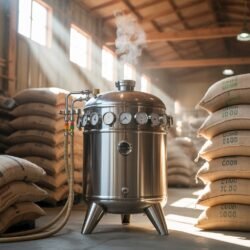Anaerobic fermentation is no longer just a secret weapon for specialty coffee producers—it’s quickly becoming a favorite among coffee drinkers everywhere. But what exactly is driving this surge in popularity? Let’s dive deep into the world of anaerobic coffee, exploring the trends, tastes, and transformations that are making it the talk of the town.
The Rise of Unique Flavor Experiences
Coffee lovers are always on the hunt for something new and exciting, and anaerobic fermentation delivers just that. By fermenting coffee cherries in sealed, oxygen-free tanks, producers encourage the growth of specific yeasts and bacteria that create bold, complex flavors not found in traditional coffees. Think tropical fruit, berry, winey acidity, and even hints of spice or funk—these are the hallmarks of a well-executed anaerobic process.
The controlled environment allows for a slower, more deliberate fermentation, which means more time for those unique flavor compounds to develop. This results in cups that are vibrant, layered, and often surprising, offering an experience that stands out in a crowded market.
Specialty Coffee and the Search for Authenticity
The specialty coffee movement is all about quality, traceability, and authenticity. Consumers want to know where their coffee comes from, how it’s made, and who’s behind it. Anaerobic fermentation fits perfectly into this narrative, as it’s a method that requires skill, patience, and a bit of scientific know-how.
Producers who embrace anaerobic processing often share their stories—detailing the specific techniques, the length of fermentation, and even the microbial cultures used. This transparency resonates with coffee drinkers who value craftsmanship and want to connect with the people and processes behind their daily brew.
The Influence of Café Culture and Social Media
Walk into any trendy coffee shop, and you’re likely to find at least one anaerobic coffee on the menu. Baristas love to showcase these unique offerings, and customers are eager to try something different. The visual appeal of anaerobic fermentation—sealed tanks, bubbling valves, and the promise of something out of the ordinary—makes it a natural fit for Instagram and TikTok, where coffee culture thrives.
Influencers and coffee enthusiasts share their tasting notes and brewing tips, sparking curiosity and driving demand. The result? A growing community of coffee drinkers who are excited to explore new flavors and share their discoveries with friends and followers.
Health, Wellness, and the Quest for Novelty
While anaerobic coffee isn’t necessarily “healthier” than other types, it does tap into broader trends around health and wellness. Consumers are increasingly interested in products that offer both enjoyment and a sense of discovery. Anaerobic fermentation, with its clean, complex flavors and innovative processing, aligns well with this mindset[3][4].
The novelty factor is also a big draw. In a world where so many products feel mass-produced, anaerobic coffee stands out as something special—a limited-edition experience that’s worth savoring.
Sustainability and Ethical Considerations
Sustainability is a growing concern for many coffee drinkers, and anaerobic fermentation can play a role here, too. While the method itself isn’t always more sustainable than others, it’s often associated with small-batch, high-quality production that emphasizes traceability and ethical sourcing.
Producers who use anaerobic fermentation are often deeply invested in their craft, paying close attention to every step of the process. This attention to detail can lead to more sustainable practices, such as better waste management, reduced water usage, and a focus on fair labor. For consumers who care about the planet and the people behind their coffee, this is a powerful selling point.
The Risks and Rewards for Producers
Anaerobic fermentation isn’t without its challenges. It requires specialized equipment, careful monitoring, and a willingness to take risks. But for producers who get it right, the rewards can be significant—higher prices, greater recognition, and a loyal following of coffee lovers who crave something new.
The method is still evolving, with producers experimenting with different fermentation times, temperatures, and even adding ingredients like fruit or spices to the tanks. This spirit of innovation keeps the market fresh and exciting, ensuring that there’s always something new to discover.
The Future of Anaerobic Coffee
As the specialty coffee market continues to grow, anaerobic fermentation is poised to play an even bigger role. Producers are pushing the boundaries of what’s possible, and consumers are eager to follow along on the journey. Whether you’re a seasoned coffee aficionado or just starting to explore the world of specialty brews, anaerobic coffee offers a taste of the future—bold, complex, and full of surprises.


